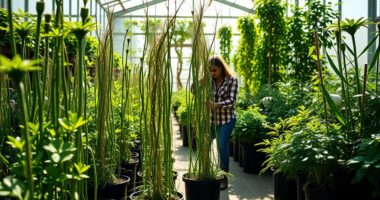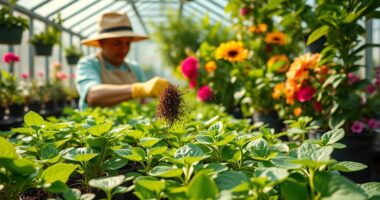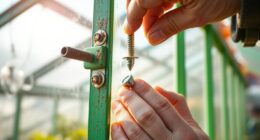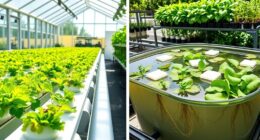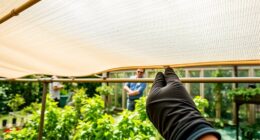To grow carrots in a greenhouse, choose varieties like Nantes or Danvers that suit your preferences. Prepare light, loose soil with a pH of 6.0 to 6.8. Sow seeds ¼ to ½ inch deep, spacing them ½ inch apart. Keep the temperature between 55°F and 75°F and humidity around 80%. Water weekly, ensuring soil stays moist but not soggy. Regularly thin seedlings and monitor for pests. There's more to discover on achieving a bountiful harvest.
Key Takeaways
- Choose the right carrot variety based on soil type and climate, such as Nantes for sweetness or Danvers for juicing.
- Prepare the soil by loosening it to at least 12 inches deep and ensuring a pH between 6.0 and 6.8.
- Sow seeds ¼ to ½ inch deep, spaced ½ inch apart, in spring or fall while maintaining temperatures between 40°F and 65°F.
- Keep seedlings well-watered with at least one inch of water weekly, and avoid overcrowding by thinning them appropriately.
- Maintain temperatures between 55°F and 75°F and humidity around 80% for optimal growth, using sensors and automated systems for control.
Choosing the Right Carrot Variety for Greenhouse Growing
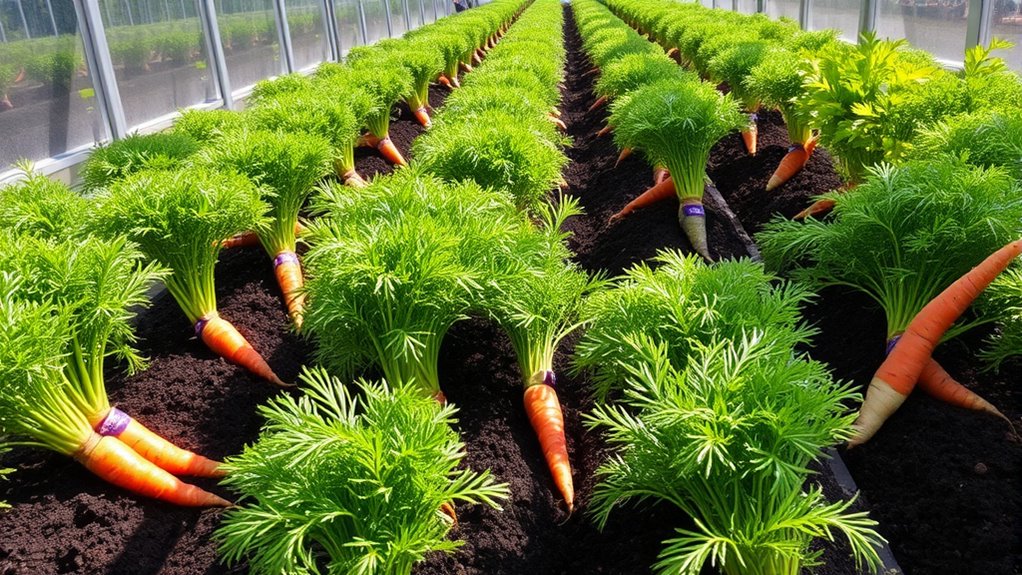
When you're choosing the right carrot variety for greenhouse growing, it's important to contemplate factors like soil type, climate tolerance, and disease resistance.
For instance, Nantes carrots are sweet and crunchy, thriving in heavy soils, while Danvers carrots make a classic choice for juicing and cooking.
If you're working with containers, consider Little Finger carrots for their compact size.
Bolero carrots are excellent for disease resistance, ensuring a healthy crop.
If your soil is clay-based, Thumberlina carrots can adapt well.
Be aware of your greenhouse's climate; cooler temperatures are ideal.
Choose varieties that suit your specific conditions for the best results, and you'll enjoy a fruitful carrot harvest in no time.
Preparing the Soil for Optimal Growth
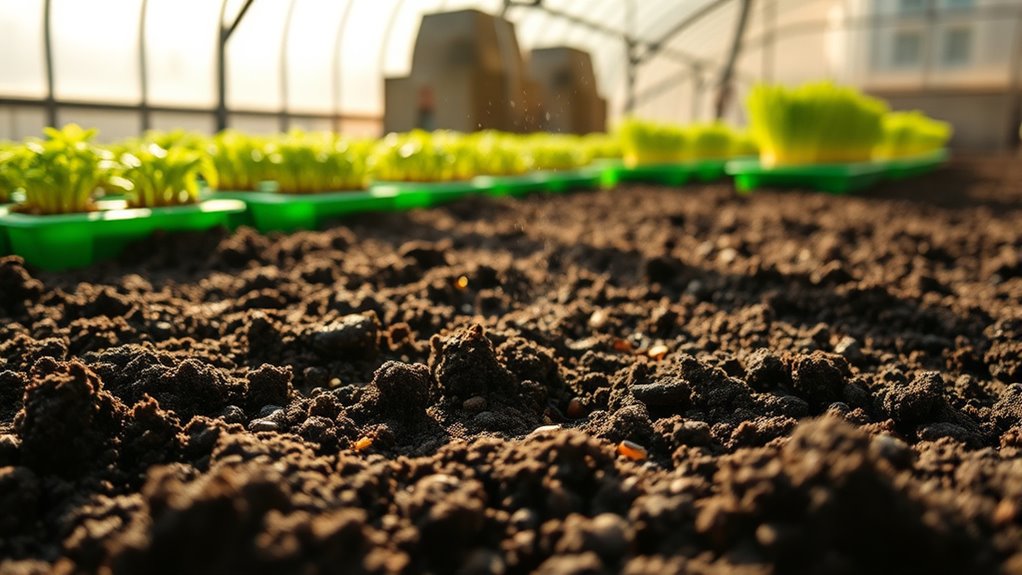
To guarantee your carrots grow strong and healthy, start by preparing the soil properly. Carrots thrive in light, loose, and loamy soil, so avoid heavy clay or compacted mixes.
Prepare your soil well; carrots flourish in light, loose, and loamy conditions for optimal growth.
Work the soil to a depth of at least 12 inches to promote ideal root growth. Aerate the soil by forking it thoroughly, breaking up lumps for better drainage. Remove any stones and debris that might obstruct root development.
Test the soil pH, aiming for a slightly acidic range between 6.0 and 6.8. Add compost sparingly to enhance fertility without overwhelming the soil.
Finally, make sure your soil is weed-free and consider applying a balanced fertilizer one week before sowing for the best results.
Sowing Carrot Seeds in a Greenhouse Environment

With the soil prepared for your carrot crop, it's time to focus on sowing the seeds in your greenhouse environment.
Choose heirloom or hybrid seeds, and remember, you can sow them in spring, fall, or winter since they tolerate cooler temperatures.
Plant seeds ¼ to ½ inch deep, spacing them about ½ inch apart. Ideal germination occurs between 40°F and 65°F, so maintain those temperatures for best results.
After sowing, gently firm the soil to guarantee good seed-to-soil contact. Rows should be spaced 12-24 inches apart, and later, thin seedlings to 1-4 inches apart for maximum growth.
Monitor moisture levels closely to support germination and prevent crusting that could hinder seedling emergence.
Caring for Carrot Seedlings in Controlled Conditions
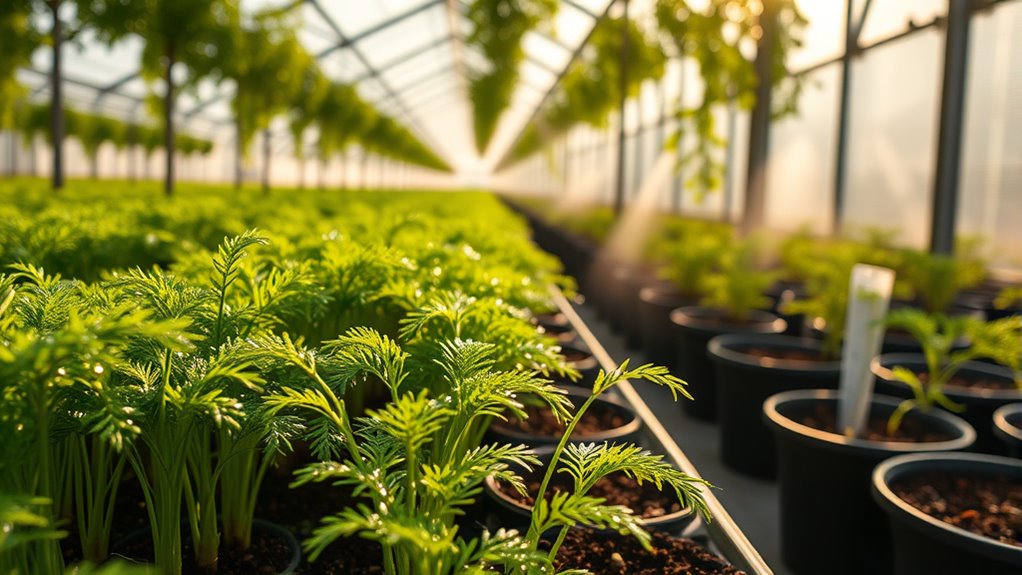
As you nurture your carrot seedlings in a controlled greenhouse environment, it's essential to guarantee ideal soil conditions for their development.
Confirm the soil is aerated, free of large stones, and maintains a pH level between 6.0 and 6.8. Keep the soil consistently moist but not soggy to prevent root rot, aiming for at least one inch of water weekly. Be gentle when watering to avoid displacing seeds or seedlings.
As seedlings germinate, thin them carefully to prevent overcrowding, maintaining a spacing of 1-4 inches. Remove weaker seedlings to minimize disease risk.
Finally, avoid using manure and consider potassium-rich liquid feeds or slow-release fertilizers to support their growth effectively. Regular weeding also helps keep your seedlings healthy.
Managing Temperature and Humidity Levels
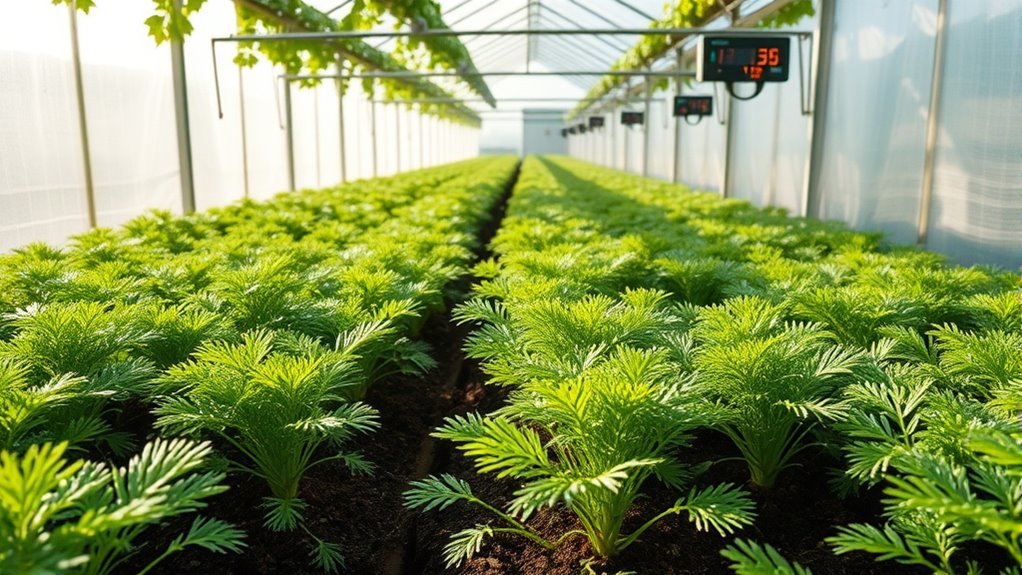
While managing temperature and humidity levels in your greenhouse, you'll create an environment that fosters healthy carrot growth. Aim to keep temperatures between 55°F and 75°F, with suitable daytime temperatures around 75°F and nighttime temperatures near 55°F.
Remember, temperatures above 80°F can hinder seed germination and growth. For humidity, maintain around 80% relative humidity to support ideal growth, but be cautious as high humidity can lead to pests and diseases.
Use humidity sensors to monitor levels, and guarantee proper air circulation to manage both temperature and humidity effectively. Implement automated temperature control systems, and consider natural ventilation methods to maintain the right conditions for your carrots throughout their growing season.
Effective Watering Techniques for Carrots

Creating the right temperature and humidity levels in your greenhouse sets the stage for effective watering techniques, which are essential for growing healthy carrots.
Start by preparing well-drained, loose soil with a pH between 6.0 and 6.8. Keep the soil consistently moist until seeds germinate, then adjust your watering frequency as the plants establish.
Water deeply but less frequently to encourage robust root growth. Monitor soil moisture by checking with your finger, and use organic mulch to retain moisture and suppress weeds.
Always water in the morning or evening to minimize evaporation. Avoid overwatering, as it can lead to root deformation or rot.
With these techniques, you'll cultivate thriving carrots in your greenhouse.
Implementing Companion Planting Strategies
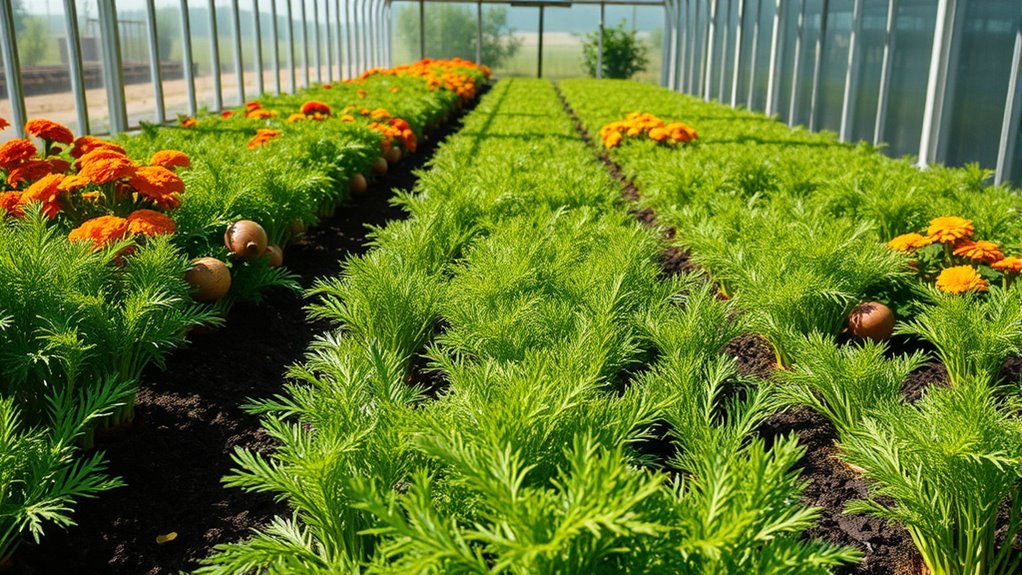
Implementing companion planting strategies can greatly enhance your carrot-growing success in a greenhouse. By pairing carrots with plants like leeks or onions, you can repel pests such as carrot flies, reducing your reliance on pesticides.
Additionally, incorporating herbs like rosemary and sage helps mask the scent of carrots, further protecting them from pests.
Consider using lettuce and greens, as they utilize different soil layers, optimizing space. Amaranth can improve soil conditions, while tomatoes might provide shade, but placement is key.
Remember to create microclimates to accommodate each plant's needs. This diverse approach not only boosts your carrot health but also promotes a thriving ecosystem in your greenhouse. Furthermore, incorporating nutritional benefits such as chia seeds can enhance soil health and nutrient availability for your carrots.
Monitoring for Pests and Diseases
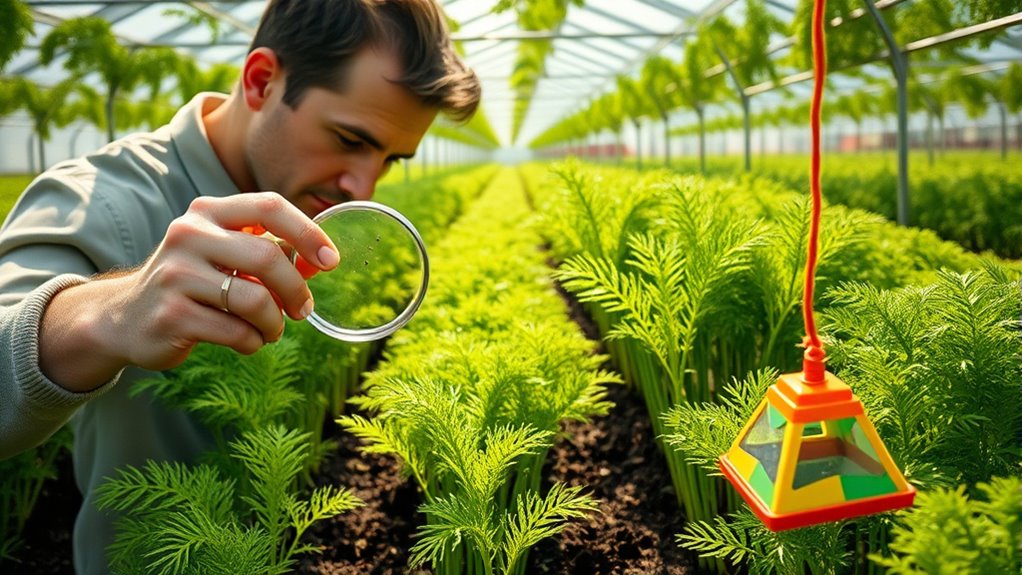
Start with regular visual inspections of your plants to spot any signs of damage. Keep an eye out for common pests like aphids and spider mites. You can also use yellow sticky traps to catch flying pests like whiteflies.
Consider soil sampling for nematodes before planting to protect your roots. Employ beneficial insects, such as ladybugs, to naturally control aphids. Additionally, ensure your carrots receive proper nutrition to support healthy growth and enhance their resilience against pests.
Practice crop rotation and sanitize your tools to minimize disease risk. Finally, maintain good ventilation to prevent fungal issues.
Harvesting and Storing Your Carrot Crop

Harvesting your carrot crop is an exciting milestone in the gardening process. You'll know they're ready when the diameter just below the soil line reaches 1/2 to 3/4 inch. Look for signs like withering leaves or full-sized greens, signaling maturity.
Use a digging fork to loosen the soil without breaking your carrots, and pull them gently by their tops if the soil is loose. Trim the leaves down to about an inch to reduce moisture loss.
For storage, keep them in a cool, humid environment at 32°F, avoiding ethylene-producing fruits. You can also refrigerate them for a couple of weeks or store in moist sand for longer freshness.
Enjoy your delicious harvest!
Frequently Asked Questions
Can I Grow Carrots Year-Round in a Greenhouse?
Yes, you can grow carrots year-round in a greenhouse!
Just make sure you maintain temperatures between 55°F and 65°F, and provide at least six hours of sunlight daily.
Use loose, well-drained soil for best growth, keeping it consistently moist without overwatering.
Choose varieties like Nantes or Chantenay for better cold tolerance.
What Lighting Conditions Are Ideal for Carrot Growth?
You can't expect your carrots to thrive in the dark like moles! Ideally, they need 6-8 hours of direct sunlight each day.
If natural light dips, supplement with LED grow lights or fluorescent bulbs to keep them beaming. Aim for a light intensity of 700-1000 foot-candles.
Balancing light and temperature is essential, so don't let your carrots feel like they're in a sauna—keep conditions cool and inviting for ideal growth!
How Can I Prevent Bolting in Carrots?
To prevent bolting in carrots, you'll want to plant them during cooler seasons and directly sow the seeds to reduce root disturbance.
Keep your soil well-draining and free of stones, and choose varieties that resist bolting.
Managing temperature is vital, so maintain cooler conditions below 75°F, provide shade during heat, and keep moisture consistent without overwatering.
Regularly monitor for pests and stressors to guarantee your carrots grow healthy and flavorful.
What Are the Ideal Greenhouse Humidity Levels for Carrots?
The ideal humidity levels for carrots in a greenhouse range from 90% to 95%. This high humidity supports their growth and helps prevent diseases.
To maintain these levels, you should manage ventilation carefully, ensuring adequate air circulation. If humidity becomes excessive, consider using dehumidifiers.
Regularly monitor moisture levels with meters, adjusting as needed to keep your carrots thriving while avoiding waterlogged conditions that could harm their roots.
Can I Use Recycled Soil for Growing Carrots?
Imagine your carrots thriving in a cozy, nutrient-rich bed of recycled soil. Yes, you can use recycled soil for growing carrots, but it's crucial to verify it's well-draining and not overly fertile.
By mixing in sand or perlite, you'll improve drainage and promote healthy root development. Just keep an eye on moisture levels and nutrient balance.
With the right care, your recycled soil can nurture a bountiful carrot harvest.
Conclusion
Growing carrots in a greenhouse can be a rewarding endeavor, turning your space into a vibrant patch of orange gold. By carefully selecting your variety, preparing your soil, and nurturing your seedlings, you'll cultivate not just vegetables but a sense of accomplishment. Remember, just like carrots thrive in the right conditions, so do your gardening skills—nurture them with patience, and you'll reap the fruits of your labor. Happy gardening!



